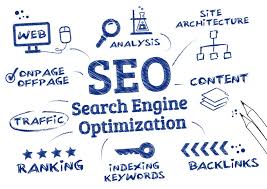Mastering the Art of SEO Web Development: A Guide to Building Search-Optimised Websites
The Intersection of SEO and Web Development
In the digital landscape, the synergy between SEO and web development plays a crucial role in determining the success of a website. SEO web development involves incorporating search engine optimization best practices into the very fabric of a website’s design and structure.
Key Elements of SEO Web Development
Site Speed: A fast-loading website is not only user-friendly but also favoured by search engines. Optimising code, images, and server response time are essential for improving site speed.
Mobile Responsiveness: With mobile devices accounting for a significant portion of web traffic, ensuring that your website is responsive across various screen sizes is imperative for both user experience and SEO rankings.
Structured Data: Incorporating structured data markup helps search engines better understand your content, leading to enhanced visibility in search results through rich snippets and knowledge graphs.
URL Structure: Clean and descriptive URLs not only aid users in understanding the content but also provide search engines with valuable information about the page’s topic.
The Impact on SEO Rankings
An SEO-friendly website developed with best practices in mind can positively impact your search engine rankings. Search engines reward websites that are well-structured, fast-loading, and provide a seamless user experience across devices.
The Future of SEO Web Development
As search engines evolve and algorithms become more sophisticated, the importance of integrating SEO principles into web development will only continue to grow. Websites that prioritise user experience, accessibility, and relevance will stand out in an increasingly competitive online landscape.
6 Key Advantages of SEO Web Development: Boosting Visibility, User Experience, and Credibility
- Enhances website visibility in search engine results pages (SERPs)
- Improves user experience through faster loading times and mobile responsiveness
- Increases organic traffic by optimising for relevant keywords and structured data
- Boosts website credibility and trustworthiness with clean URL structures
- Facilitates better indexing of website content by search engines
- Future-proofs the website against algorithm updates with SEO best practices
Challenges in SEO Web Development: Time, Errors, Flexibility, and Updates
- Increased Development Time
- Potential for Technical Errors
- Limited Flexibility
- Constant Updates Required
Enhances website visibility in search engine results pages (SERPs)
By implementing SEO web development practices, websites can significantly enhance their visibility in search engine results pages (SERPs). Optimising the website structure, content, and technical elements according to SEO guidelines increases the chances of ranking higher in search results. This improved visibility not only drives more organic traffic to the website but also boosts brand awareness and credibility among users searching for relevant information or products/services. Ultimately, a well-optimised website stands a better chance of attracting quality leads and converting them into loyal customers.
Improves user experience through faster loading times and mobile responsiveness
By implementing SEO web development practices, websites can significantly enhance user experience by ensuring faster loading times and mobile responsiveness. This proactive approach not only caters to the growing number of mobile users but also creates a seamless browsing experience for all visitors. Websites that load quickly and adapt to different devices not only satisfy user expectations but also tend to rank higher in search engine results, ultimately driving more traffic and engagement.
Increases organic traffic by optimising for relevant keywords and structured data
By incorporating SEO principles into web development, websites can experience a significant boost in organic traffic. This is achieved by strategically optimising for relevant keywords and implementing structured data markup to enhance search engine visibility. By aligning website content with user search intent and providing search engines with clear signals through structured data, SEO web development ensures that the right audience discovers the website through organic search results, ultimately driving increased traffic and engagement.
Boosts website credibility and trustworthiness with clean URL structures
A significant advantage of incorporating SEO principles into web development is the ability to enhance website credibility and trustworthiness through clean URL structures. By ensuring that URLs are clear, descriptive, and relevant to the content they represent, users and search engines alike can easily understand the purpose of each page. This transparency not only improves user experience but also signals to search engines that the website is well-organised and trustworthy, ultimately boosting its credibility in the eyes of both visitors and search algorithms.
Facilitates better indexing of website content by search engines
Facilitating better indexing of website content by search engines is a key advantage of SEO web development. By structuring the website in a search engine-friendly manner, incorporating relevant keywords, and implementing proper meta tags, SEO web development ensures that search engines can easily crawl and index the site’s content. This proactive approach not only increases the visibility of the website in search engine results but also helps in ranking higher for relevant keywords, ultimately driving more organic traffic to the site.
Future-proofs the website against algorithm updates with SEO best practices
Future-proofing a website against algorithm updates by implementing SEO best practices through web development is a strategic advantage in the ever-evolving digital realm. By adhering to SEO guidelines, such as optimising site speed, enhancing mobile responsiveness, and incorporating structured data, a website can maintain its visibility and ranking stability despite changes in search engine algorithms. This proactive approach not only ensures long-term success but also demonstrates a commitment to delivering an optimal user experience that aligns with search engine expectations.
Increased Development Time
One significant drawback of SEO web development is the increased development time it entails. Incorporating SEO best practices, such as optimising site speed, enhancing mobile responsiveness, and structuring data effectively, can introduce complexity and lengthen the development process. Balancing the technical requirements of SEO with the overall design and functionality of a website may require additional time and resources, potentially delaying the launch of the site. Despite the benefits it offers in terms of search engine visibility and user experience, the extended development timeline can be a challenging aspect to navigate for businesses aiming to establish a strong online presence efficiently.
Potential for Technical Errors
In the realm of SEO web development, one significant drawback lies in the potential for technical errors to arise. Inexperienced developers navigating the complexities of SEO implementation may inadvertently introduce mistakes that result in technical issues within the website structure. These errors have the capacity to adversely impact search engine rankings, hindering the website’s visibility and overall performance in search results. It underscores the importance of entrusting SEO strategies to skilled professionals well-versed in both web development and search engine optimisation practices to mitigate such risks effectively.
Limited Flexibility
Adhering strictly to SEO guidelines in web development can present a significant drawback in terms of limited flexibility. The constraints imposed by SEO requirements may restrict the creative freedom of web developers, potentially compromising the overall design aesthetics and user experience of a website. Balancing the need for search engine optimisation with innovative design elements can be a challenging task, as prioritising one aspect over the other may lead to a less dynamic and engaging online presence. Finding the optimal equilibrium between SEO best practices and creative expression is essential to ensure that websites not only rank well but also resonate with users on a visual and interactive level.
Constant Updates Required
In the realm of SEO web development, a notable drawback lies in the necessity for constant updates. The ever-evolving nature of SEO algorithms and best practices demands regular attention to keep a website optimised for search engines. This ongoing need for updates can be time-consuming and resource-intensive, as staying abreast of the latest trends and adjusting strategies accordingly is essential to maintain visibility and rankings in search results. Failure to adapt to these changes promptly can result in a website falling behind competitors and losing valuable organic traffic.

